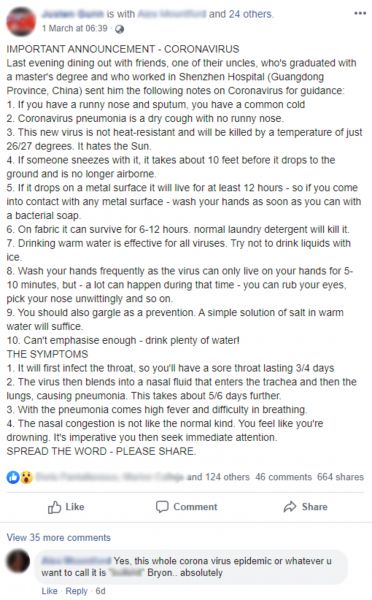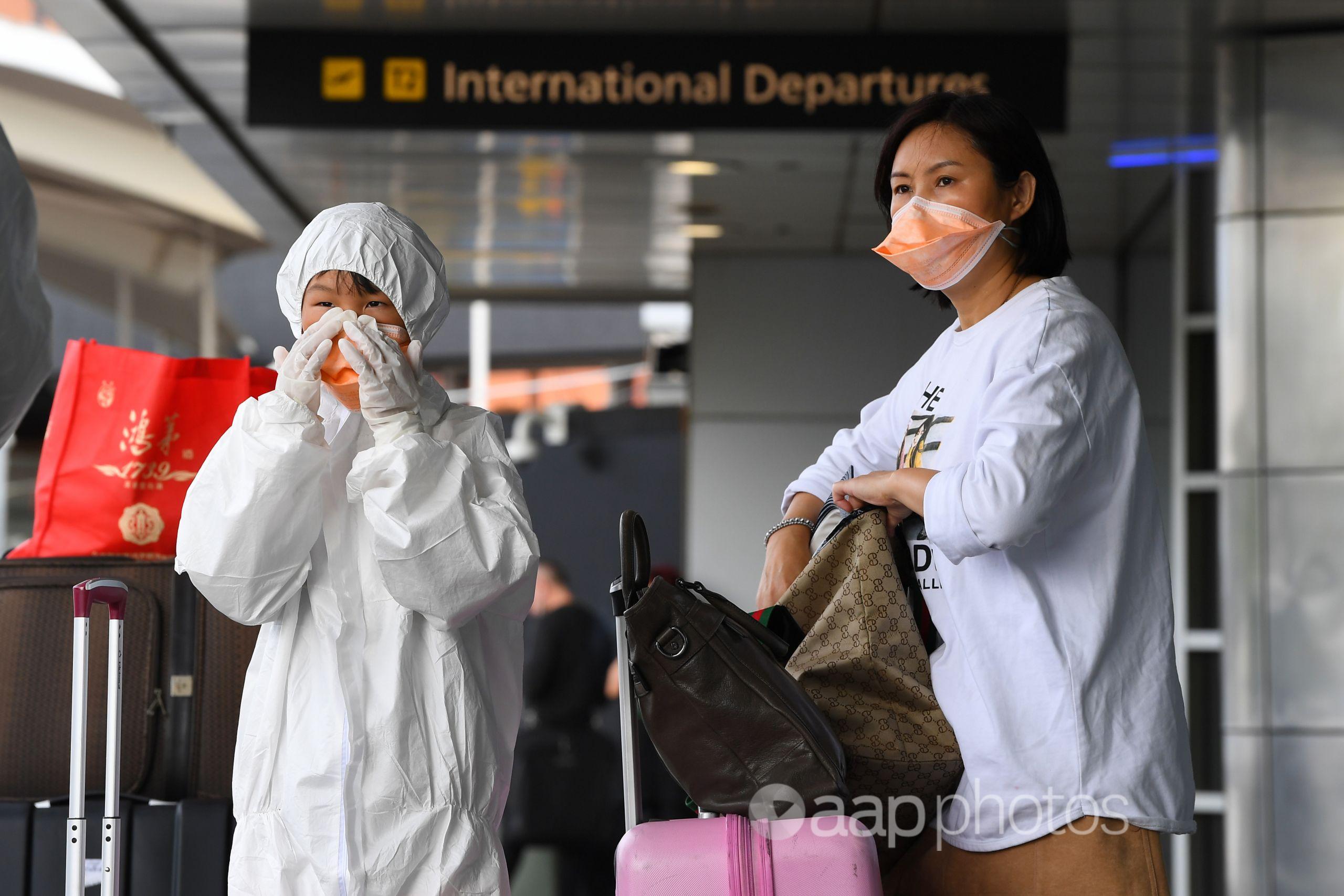The Statement
Accurate advice about COVID-19 is critical during the current pandemic and, as people seek information, a social media post purporting to list symptoms and treatments warrants scrutiny.
A March 1, 2020 Facebook post, with the headline “IMPORTANT ANNOUNCEMENT – CORONAVIRUS” tells a story of someone receiving “notes on Coronavirus for guidance” from an uncle who “graduated with a master’s degree and worked in Shenzhen hospital”.
The post then makes a series of statements and claims that reads:
“1. If you have a runny nose and sputum, you have a common cold.
2. Coronavirus pneumonia is a dry cough with no runny nose.
3. This new virus is not heat-resistant and will be killed by a temperature of just 26/27 degrees. It hates the Sun.
4. If someone sneezes with it, it takes about 10 feet before it drops to the ground and is no longer airborne.
5. If it drops on a metal surface it will live for at least 12 hours – so if you come into contact with any metal surface – wash your hands as soon as you can with a bacterial soap.
6. On fabric it can survive for 6-12 hours. normal laundry detergent will kill it.
7. Drinking warm water is effective for all viruses. Try not to drink liquids with ice.
8. Wash your hands frequently as the virus can only live on your hands for 5-10 minutes, but – a lot can happen during that time – you can rub your eyes, pick your nose unwittingly and so on.
9. You should also gargle as a prevention.
10. A simple solution of salt in warm water will suffice. Can’t emphasise enough – drink plenty of water!”
The post finishes with a timeline purporting to describe how COVID-19 infection might progress. It reads:
“1. It will first infect the throat, so you’ll have a sore throat lasting 3/4 days
2. The virus then blends into a nasal fluid that enters the trachea and then the lungs, causing pneumonia. This takes about 5/6 days further.
3. With the pneumonia comes high fever and difficulty in breathing.
4. The nasal congestion is not like the normal kind. You feel like you’re drowning. It’s imperative you then seek immediate attention.”
The post has been viewed more than 50,000 times and shared more than 660 times.

A Facebook post claims to list a series of symptoms and treatments for COVID-19 coronavirus.
The Analysis
COVID-19 has spread to more than 118 countries around the world since first reported in December 2019 and infected more than 125,000 people as of March 12, 2020, leading the World Health Organization (WHO) to declare the virus a pandemic.
The post begins with the claim that COVID-19 symptoms do not include a runny nose and sputum but rather those were just symptoms of the common cold.
According to the WHO, COVID-19 symptoms can include a runny nose.
Professor Anthony Cunningham, an infectious diseases physician from the University of Sydney, told AAP FactCheck sputum and a runny nose can be symptoms of COVID-19 however are more likely to be symptoms of the common cold.
“4.5 per cent of people with the Coronavirus actually had nasal symptoms alone. It’s of course uncommon,” he said.
The post also claims people with “coronavirus pneumonia” can display dry cough symptoms but not a runny nose.
Prof Cunningham said not everyone infected with COVID-19 will develop pneumonia and that the claim was not correct because people infected with COVID-19 can still get a runny nose with cough and fever.
“[COVID-19] causes a cold or a very mild pneumonitis in about 80 percent of people. It’s only about 15 per cent of people who get what would probably be identified by them as clinical pneumonia and five percent as critical,” he said. “[People who develop pneumonia from coronavirus] can have combinations of these symptoms.”
The post suggests that exposing the virus to a temperature of 26 to 27 degrees will kill it because COVID-19 “is not heat-resistant”, and that it “hates the sun”.
According to the US Centers for Disease Control and Prevention (CDC), it is still not known how weather and temperature will affect the spread and transmissibility of the virus.
Professor Peter Collignon, an infectious diseases physician and microbiologist from the Australian National University, told AAP FactCheck 26 to 27 degrees Celsius temperatures won’t kill the virus.
“Viruses survive quite well at lower temperatures and what would kill it is boiling it at heat more than lower temperatures. (26 to 27 degrees is) just room temperature. I don’t think it’s going to die from that,” he said.
Prof Cunningham said sunlight could be effective against coronaviruses since UV light is usually effective in disinfection.
“Exposure to UV light will actually kill off DNA. It will dry out everything so you’ll get a relative drop,” he said. “When a virus dries out, the infectivity drops substantially and chances of getting infected from dried out surfaces are extremely low.”
While the post claims COVID-19 can travel “about 10 feet” (approximately 3m) in a sneeze, 2015 advice from the Australian government’s Department of Health states respiratory droplets projected in a sneeze or cough can travel for around one metre.
The post makes a number of claims about the survival rate of the coronavirus on different surfaces, including that it lasts for at least 12 hours on a metal surface, six to 12 hours on fabrics and five to 10 minutes on someone’s hand.
The WHO, however, says it is not certain how long COVID-19 survives on surfaces but studies suggest that, like other coronaviruses, it may persist on surfaces for a few hours or up to several days.
New, yet-to-be peer-reviewed research funded by the US National Institutes of Health has found virus can survive on plastic and stainless steel for up to three days.
Prof Collignon also said the COVID-19 virus could survive longer than five to 10 minutes on a person’s hands.
The University of Sydney’s Prof Cunningham said the survival period depended on the state of the virus on the person’s hands and the environment.
“Skin defences can actually then inactivate it. The real problem is wet material like mucus from someone else’s snot actually being there and you actually touching your face,” he said.
Regarding the post’s claim that drinking warm water is “effective for all viruses” Prof Collignon said the claim was baseless, however it is important for people to stay hydrated if they have an illness.
“If you’re dehydrated, you’re not going to fight it as well so having a reasonable fluid intake is a good idea, but whether it is warm or cold, it would make no difference,” he said.
Prof Cunningham also rubbished the post’s claim that gargling salt water is a prevention,, saying the best gargling would do is provide symptomatic relief.
“That’s just nonsense. (Gargling is) for symptoms,” he said.
Prof Cunningham said the virus infects by getting into a person’s nose “not through your mouth”.
The post ends with what it claims is a pathway and timeline of symptoms people experience when they get infected with COVID-19 including a throat infection in the first three to four days then pneumonic symptoms five to six days later and then difficulty in breathing due to nasal congestion.
While these symptoms can appear in someone who has contracted COVID-19, Prof Collignon told AAP FactCheck not everyone will develop all of these and in the exact same order.
“Some people just have a mild runny nose and sore throat, a bit of a fever – that’s it. But people can also develop pneumonia but that does not happen to everyone. That just happens to people who get really sick,” he said.
Prof Cunningham said the virus would not infect the throat first due to the tough epithelium (a thin layer of tissue) down the back of the throat but rather the more delicate nasal epithelium.
“It’s really the nasopharynx (the upper airway behind the nose) which can infect the throat,” he said.
He said that infection can go down into the trachea causing pneumonia is correct, as is the post’s statement that with pneumonia comes high fever and difficulty in breathing.
The Verdict
Based on the evidence, AAP FactCheck found the post to contain a mixture of true and false claims. A runny nose, sputum, dry cough and pneumonia can be symptoms of COVID-19 however not everyone infected with the disease will have them.
Disease expert Prof Collingnon says temperatures around 26 to 27 degrees C won’t kill the virus however UV light from the sun can be effective in drying out the virus.
Understanding of how long COVID-19 survives on surfaces is limited, with the WHO referring to previous studies of other viruses to estimate a range of a few hours to a few days.
Drinking warm water, avoiding iced drinks and gargling warm salt water are not treatments or preventions, according to Prof Cunningham, however staying hydrated is important and gargling may relieve sore throats.
The timeline for progression of COVID-19 symptoms is partly accurate but not everyone will experience all of these symptoms or in that order. Prof Cunningham also said it was not accurate to say infection will happen first in the throat, as the delicate tissues behind the nose are more likely starting points.
Partly False – The claims of the content are a mixture of accurate and inaccurate, or the primary claim is misleading or incomplete.
* AAP FactCheck is accredited by the Poynter Institute’s International Fact-Checking Network, which promotes best practice through a stringent and transparent Code of Principles. https://factcheck.aap.com.au/
All information, text and images included on the AAP Websites is for personal use only and may not be re-written, copied, re-sold or re-distributed, framed, linked, shared onto social media or otherwise used whether for compensation of any kind or not, unless you have the prior written permission of AAP. For more information, please refer to our standard terms and conditions.


















